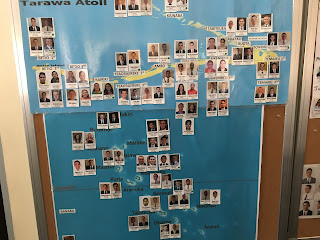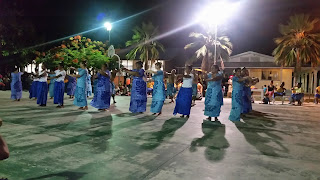People on the lagoon side out "shelling"
The new Solar/backup generator system was recently commissioned.
The solar system along with the battery bank was
installed as a secondary source of power for the School. The diesel generator
was installed as a backup/supporting, generation source. The solar panels and
inverters were installed in the first phase of installation. Then a couple of months later the
Multicluster controls & battery bank and the backup generator were shipped to the
school. Both systems came as self contained systems in cargo containers. They
were assembled and tested at the supplier and then shipped to Tarawa for site
installation. The complete electrical system is designed to be fully automatic
with little to no operator input. The solar system was sized at 125kW to meet
full load demand during School hours. On bright sunny days, weekends and
holidays it produces more than is needed. The generator is sized to 200kW and
can handle the full load of the School grid easily. The order of priority is
the PUB, then the solar source, then battery source, then diesel generator
source. All the sources of electrical energy are tied together through the
Multicluster control system. Each source can be isolated from the School grid
system.
On the left are the old backup generators which are no longer functioning. They have been given away to the PUB for spare parts. The PUB will try to have them removed by June.
This is the battery room and Multicluster control system. The battery inverters have a continuous power rating of 72kW and can supply 96kW for 30 minutes and 115kW for 60 seconds. If the load is below 60kW then the Multicluster system can supply the school from the batteries for 2 - 3 hrs before it tasks the generator to start based on a low battery request.
This is the backup generator. It has a 200 kW maximum continuous output. Our maximum school load is about 100 kW. It is a Cummins Diesel which burns about 50 liters of fuel an hour.
The backup generator has capability of its own automatic controls, but since it is tied to the solar power source it is controlled by the solar system controls.
This is the Multicluster master controller.
These are the cluster control boxes that control the inverters.
This is the auto switch to tie in PUB grid (Public Utilities grid) power.
In normal operation the PUB grid power passes
through the Multicluster system and supplies the electrical load to the school.
During the daylight hours the solar inverters are connected into the grid and
help to lower the school load on the PUB grid. In the middle of the day when
the sun is brightest the solar inverters can provide up to 100% of school
electrical needs. In the mornings, in the evenings, and on cloudy days the
solar output is low, so the PUB grid makes up for electrical load. At night the
PUB provides for school needs and recharging batteries.
If there is a loss of PUB power source then the
Multicluster system transfers instantly to battery backup mode and supplies
power from the batteries to the school. If the load is greater than 60 kW then
the Multicluster system is programmed to start the backup generator. After a 1
minute system check the generator starts and has a 1 minute warmup time. After the warmup
time the generator relay closes and becomes the source of power for the system
to handle load and charge the batteries. When PUB becomes available again the
system monitors the PUB source for 1 minute to insure stability and then shuts
off the generator and closes in the PUB source.
If there is a phase
imbalance or there is a loss of one or 2 phases from the PUB then the PUB grid
is disconnected and the whole system shuts down. This is a safety feature to
protect the Multicluster control system. The solar system goes through a
restart. This takes about 4 minutes to complete. During this time the school is
without power. After the restart, the solar system starts up and restores power
to the school. Once the PUB is restored the Multicluster system monitors it for
1 minute to insure stability and then switches the system back to PUB grid
power.So for the last few weeks we have been running on the new system. There have been a few issues and bugs we had to work out but the system seems to be very reliable. For me it has been enjoyable to work with the supplier and the Church Engineer in helping them commission this new system.






















































